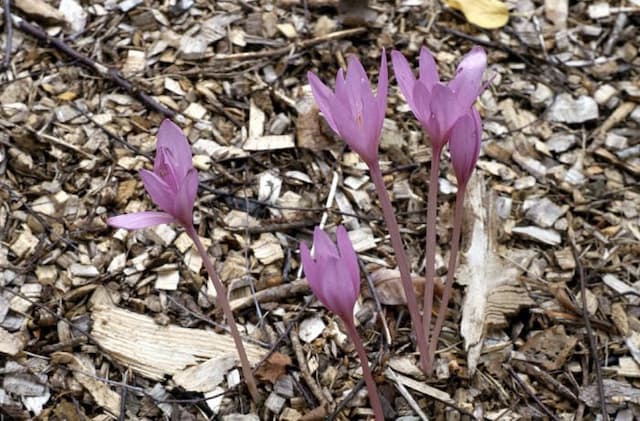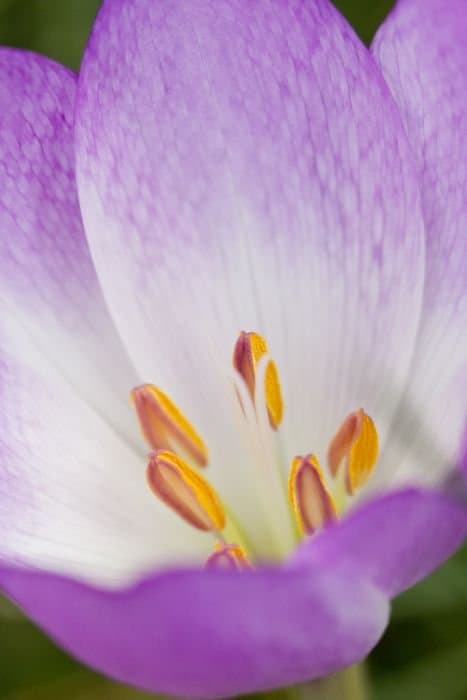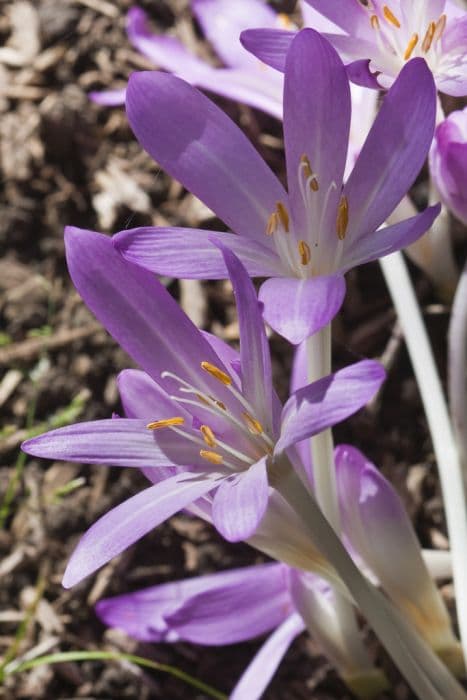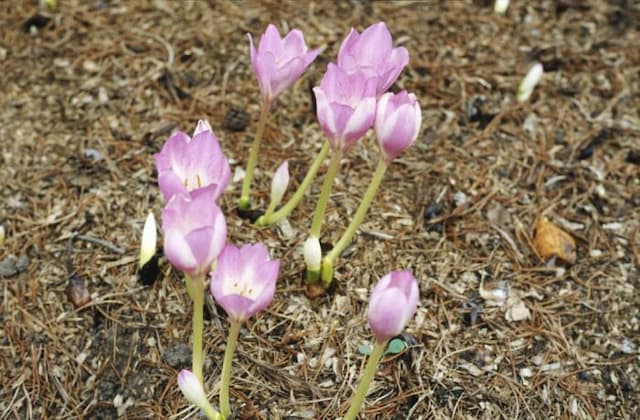Large-flowered Bellwort Uvularia grandiflora

ABOUT
Uvularia grandiflora, commonly known as large-flowered bellwort, has a distinct and elegant appearance. This plant is characterized by its drooping, bell-shaped yellow flowers that boast a unique six-petaled design. Each petal is elongated and twists slightly, adding to the flower's visual appeal. The interior of the blooms has a smooth, waxy texture that contrasts with their exterior. The leaves of large-flowered bellwort are bright green and possess a lance-like shape, giving them a pointed appearance. Additionally, the foliage often encircles the stem, creating an almost whorled pattern, which adds to the plant's delicate aesthetic. The stems are slender and arch gracefully, allowing the artistically hanging flowers to take center stage. With its gentle yellow hues and tender green foliage, large-flowered bellwort is a delightful addition to any setting where its intricate beauty can be appreciated.
About this plant
 Names
NamesFamily
Colchicaceae.
Synonyms
Largeflower Bellwort, Large-flowered Bellwort, Merrybells, Large-flowered Merrybells, Great Merrybells, American Bellwort.
Common names
Oakesiella grandiflora, Uvularia perfoliata var. grandiflora
 Toxicity
ToxicityTo humans
Uvularia grandiflora, commonly known as large-flowered bellwort, is not generally considered to be a poisonous plant to humans. There is no well-documented evidence of toxicity in humans, and it does not appear on toxic plant lists maintained by poison control centers or botanical gardens. Hence, the consumption or contact with large-flowered bellwort does not typically result in poisoning or produce symptoms associated with plant toxicity in humans.
To pets
Uvularia grandiflora, or large-flowered bellwort, is also not known to be toxic to common pets such as dogs and cats. This plant does not appear on lists of poisonous plants for pets provided by organizations such as the ASPCA (American Society for the Prevention of Cruelty to Animals). Ingesting this plant is unlikely to result in poisoning or display toxicity symptoms in most pets. However, it is always wise to prevent pets from ingesting plants as individual animals may have varying sensitivities, and non-toxic plants can still cause gastrointestinal upset if consumed in large amounts.
 Characteristics
CharacteristicsLife cycle
Perennials
Foliage type
Deciduous
Color of leaves
Green
Flower color
Yellow
Height
1-2 feet (30-60 cm)
Spread
1 foot (30 cm)
Plant type
Herb
Hardiness zones
5
Native area
North America
Benefits
 General Benefits
General Benefits- Attracts Pollinators: Uvularia grandiflora, also known as large-flowered bellwort, brings in bees and beneficial insects that are crucial for pollination.
- Aesthetic Appeal: The unique, pendulous, yellow flowers and lush foliage add an elegant touch to any garden space.
- Native Species Conservation: By planting Uvularia grandiflora, gardeners support local ecosystems and biodiversity.
- Shade Tolerance: Large-flowered bellwort thrives in shaded areas where other plants might struggle, making it a good choice for woodland gardens.
- Naturalization: Uvularia grandiflora can spread and naturalize in appropriate conditions, creating a low-maintenance, self-sustaining garden feature.
- Food Source for Wildlife: The seeds and foliage provide a food source for certain wildlife species, integrating the plant into the local food web.
- Erosion Control: The root system of large-flowered bellwort helps to stabilize soil and can be used in areas prone to erosion.
- Seasonal Interest: It has a period of visual interest in the spring when it blooms, contributing to the seasonal dynamics of a garden.
 Medical Properties
Medical PropertiesThis plant is not used for medical purposes.
 Air-purifying Qualities
Air-purifying QualitiesThis plant is not specifically known for air purifying qualities.
 Other Uses
Other Uses- Uvularia grandiflora, also known as bellwort, can be used in floral arrangements for its delicate, nodding yellow flowers and graceful foliage.
- Bellwort serves as an attractive ground cover in shaded garden areas, thanks to its spreading habit and pleasant greenery.
- The plant can be a food source for white-tailed deer, which may feed on its leaves and stems in their natural woodland habitat.
- Bellwort can be used in woodland garden design to create a naturalized, wild look that mimics its native environment.
- The flowers of Uvularia grandiflora offer a subtle appeal for early spring pollinators like bees when other food sources are scarce.
- Bellwort's seed pods can add a unique textural element to dried flower arrangements and craft projects.
- The plant can serve as an indicator species for certain soil types, such as rich, moist woods, helping gardeners gauge the health of the environment.
- Bellwort may provide a modest ecological benefit by stabilizing soil with its rhizomes, reducing soil erosion in shaded areas.
- You can use the plant as part of a native plant education program, as it is a species indigenous to Eastern North America.
- Gardeners interested in phenology, or the study of plant and animal life cycle events, may include Uvularia grandiflora to observe its timing of blooming as a sign of spring's progression.
Interesting Facts
 Feng Shui
Feng ShuiThe Large-flowered Bellwort is not used in Feng Shui practice.
 Zodiac Sign Compitability
Zodiac Sign CompitabilityThe Large-flowered Bellwort is not used in astrology practice.
 Plant Symbolism
Plant Symbolism- Delicacy: Uvularia grandiflora, commonly known as Large-flowered Bellwort or wild oats, often symbolizes delicacy due to its fine, pendulous flowers and slender stems.
- Grace: Its graceful drooping yellow flowers can represent grace and elegance in natural settings.
- Unassuming Beauty: Large-flowered Bellwort's subtle beauty is emblematic of understated or unnoticed charm, often growing in the shadow of larger woodland plants.
- Perseverance: As a woodland perennial, it signifies the quality of perseverance by coming back year after year and thriving in the dappled light of competitive forest environments.
 Water
WaterLarge-flowered bellwort should be watered when the top inch of the soil feels dry to the touch; typically, this will be about once a week. Provide enough water each time to moisten the soil throughout the pot, which might be around half a gallon for a medium-sized container, though the exact amount can vary depending on the size of the plant and environmental conditions. During the active growing season in spring and summer, keep the soil consistently moist but not soggy. Reduce watering frequency in the fall and winter months when the plant's growth slows down. Always use a pot with drainage holes to prevent waterlogging, which could lead to root rot.
 Light
LightLarge-flowered bellwort thrives in partial to full shade, making it ideal for spots that receive dappled sunlight for part of the day, or areas with bright indirect light. Avoid placing it in full, direct sunlight, as this can scorch the leaves and damage the plant. A north-facing window or a shaded spot in the garden are suitable locations for maintaining the health of this plant.
 Temperature
TemperatureThe large-flowered bellwort prefers a temperate climate and does well in an average room temperature range between 60 to 75 degrees Fahrenheit. It can survive minimum temperatures down to about 40 degrees Fahrenheit. To ensure healthy growth, try to avoid sudden temperature fluctuations and keep the plant away from cold drafts and heating vents.
 Pruning
PruningLarge-flowered bellwort benefits from pruning to remove dead or yellowing leaves, which helps to encourage healthy growth and improve air circulation. The best time to prune is in the late winter or early spring before new growth begins. Pruning can be done annually, or whenever necessary, to maintain the desired shape and size of the plant.
 Cleaning
CleaningAs needed
 Soil
SoilLarge-flowered bellwort (Uvularia grandiflora) thrives best in a soil mix comprised of rich, well-draining loamy soil with a pH range of 5.5 to 6.5. Incorporate organic matter such as leaf mold or compost to maintain soil fertility.
 Repotting
RepottingLarge-flowered bellwort typically does not require frequent repotting and can be repotted every 2-3 years or when it outgrows its container, ensuring minimal disruption to its root system.
 Humidity & Misting
Humidity & MistingLarge-flowered bellwort prefers a moderate humidity environment, consistent with its native woodland habitat. Aim for a humidity level around 40-50% for optimal growth.
 Suitable locations
Suitable locationsIndoor
Keep it in bright, indirect light and a cool spot.
Outdoor
Partial shade, moist, rich soil, and organic mulch.
Hardiness zone
4-9 USDA
 Life cycle
Life cycleUvularia grandiflora, commonly known as large-flowered bellwort, begins its life cycle as a seed that germinates in moist, rich soil, typically in the shade of woodland environments. The seedling emerges in early spring, developing into a plant with a single stem and alternate, lance-shaped leaves. As it matures, the bellwort produces yellow, bell-shaped flowers which hang singly or in pairs from the leaf axils from April to May. Following pollination, which is mostly carried out by bees, the flowers develop into three-angled seed capsules. These capsules eventually release their seeds near the parent plant, where they can germinate to start a new life cycle. During winter, the above-ground parts of the plant die back, with the plant surviving the cold season in the form of underground rhizomes, ready to regrow the following spring.
 Propogation
PropogationPropogation time
Spring-early summer
Propogation: The most popular method of propagating Uvularia grandiflora, commonly known as large-flowered bellwort or merrybells, is by division. This typically is done in the spring or autumn when the plant is not in active bloom. To propagate by division, carefully dig up the clump of bellwort, ensuring a generous amount of soil is kept with the roots to reduce shock. Gently separate the roots into smaller sections, each with several shoots. Replant the divisions immediately at the same depth they were growing at originally, spacing them roughly 12 to 18 inches (30 to 45 centimeters) apart to allow room for growth. Water the new divisions well to help establish them. This method ensures that the new plants will be true to the parent and is an easy and effective way to increase your merrybells in the garden.









